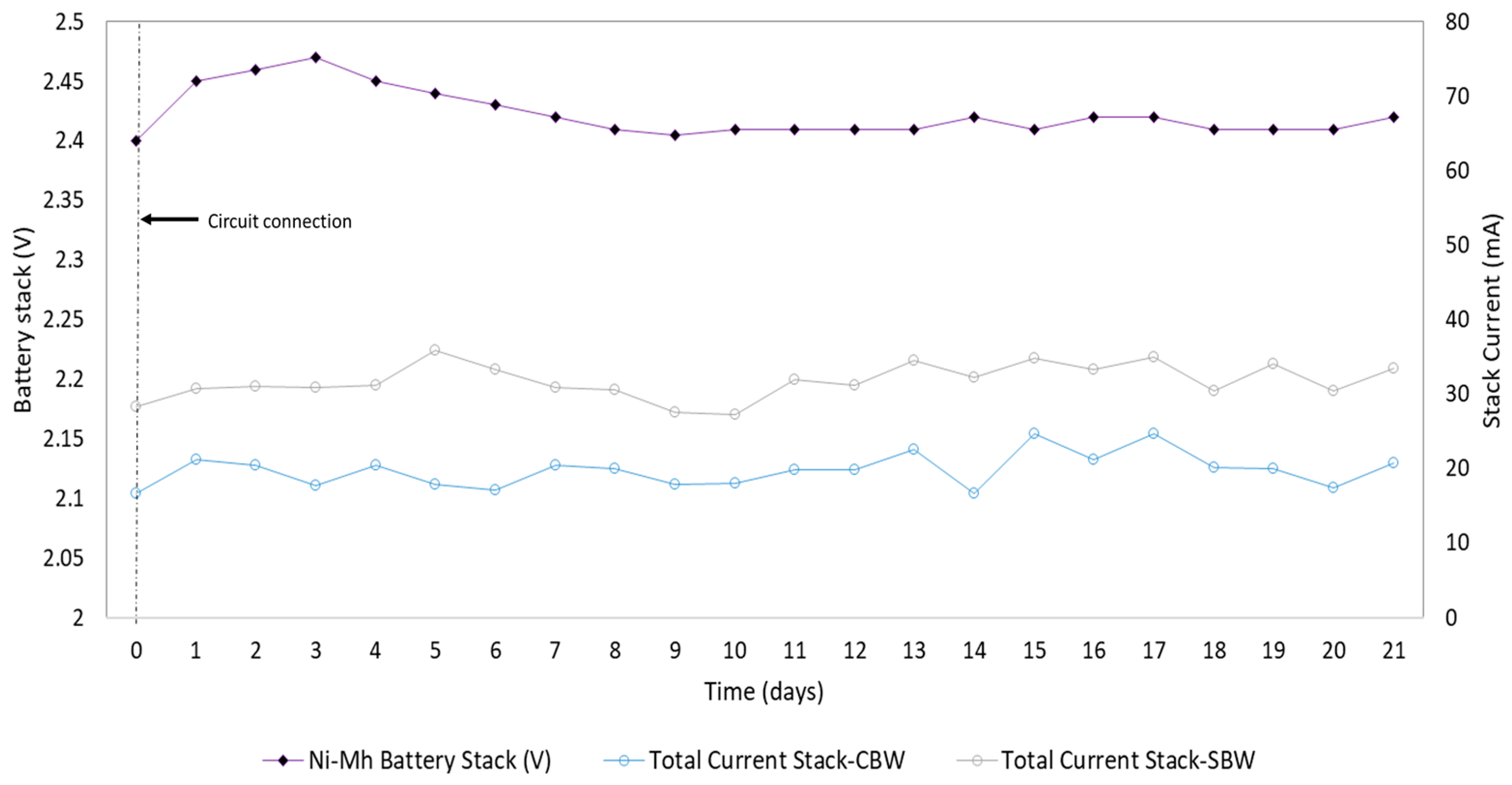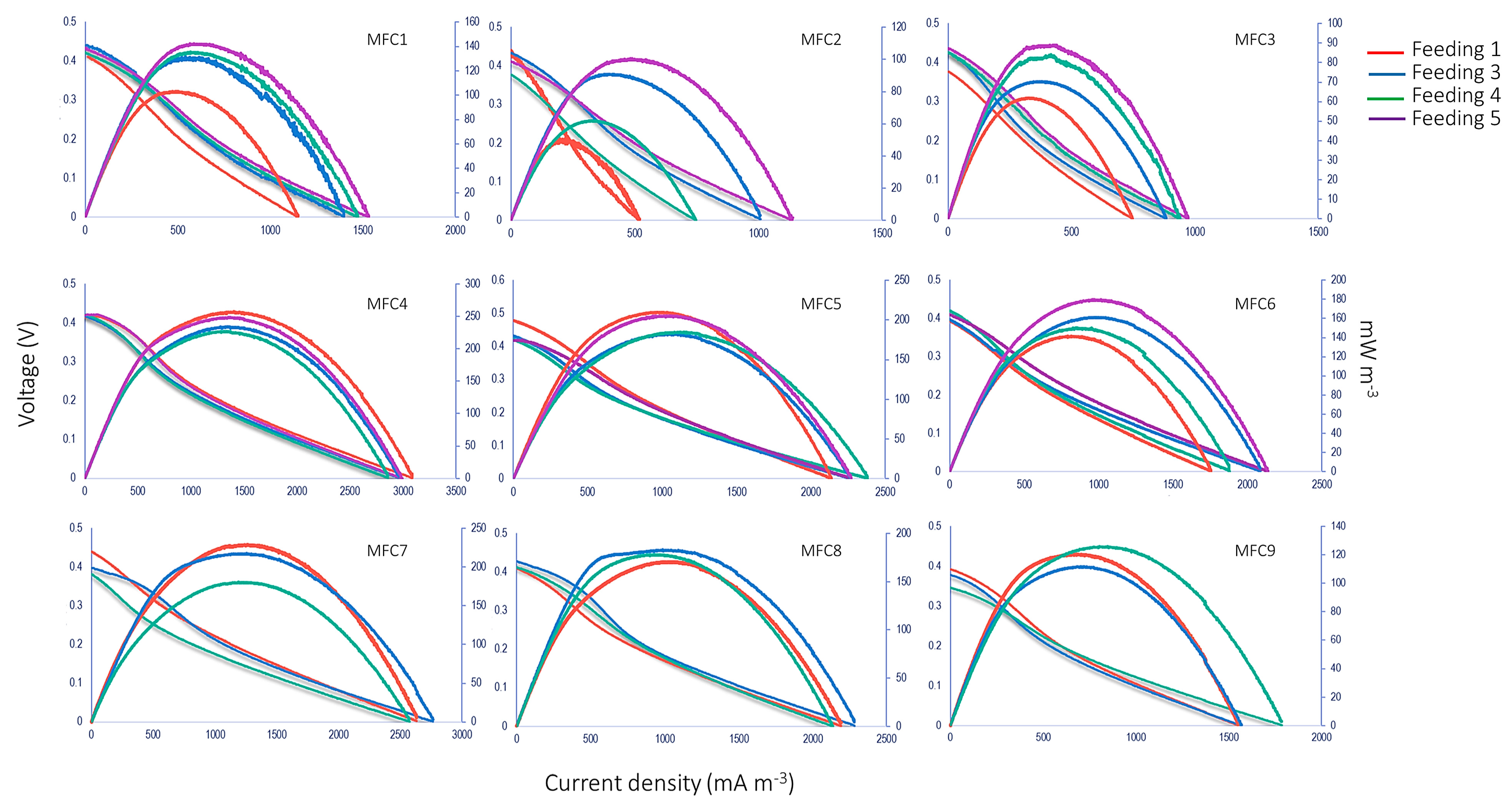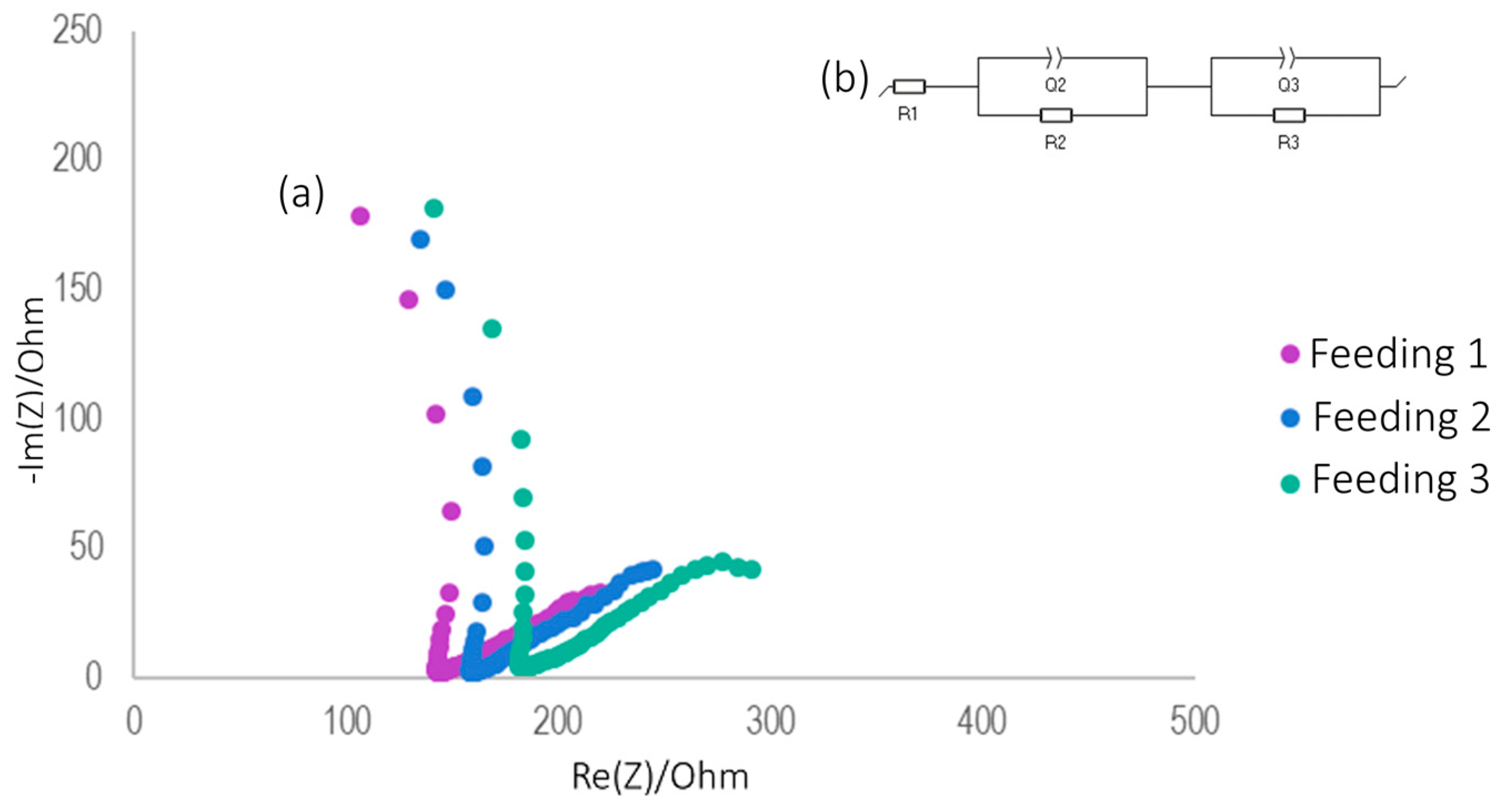Craft Brewery Wastewater Treatment in a Scalable Microbial Fuel Cell Stack
Abstract
:1. Introduction
2. Materials and Methods
2.1. Inoculum and Carbon Source
2.1.1. Inoculum
2.1.2. Synthetic Brewery Wastewater (SBW) Composition
2.1.3. Craft Brewery Wastewater (CBW)
2.2. Analytical Methods
2.2.1. Chemical Oxygen Demand (COD) and pH
2.2.2. Volatile Fatty Acids (VFA)
2.3. Building MFCs
2.3.1. Anodic Chamber
2.3.2. Membrane-Aerobic Cathode Electrode Assembly
2.3.3. Stack Assembly
2.4. Ultra-Low Power Circuit
2.5. Electrochemical Measurements
2.5.1. Voltage and Current
2.5.2. Polarization Curve and Power Density
2.5.3. Electrochemical Impedance Spectroscopy
2.5.4. Coulombic Efficiency
2.6. Statistical Analysis
3. Results and Discussion
3.1. Analytical Methods and Performance of MFCs (Stacked)
3.1.1. Chemical Oxygen Demand (COD)
3.1.2. Performance of MFCs (Stacked)
3.1.3. Volatile Fatty Acids
3.2. Ultra-Low-Power Circuit and Start-Up EHS Behavior
3.3. Electrochemical Measurements
3.3.1. Coulombic Efficiency
3.3.2. Polarization Curves
3.3.3. Electrochemical Impedance Spectroscopy
4. Limitations
5. Conclusions
Author Contributions
Funding
Institutional Review Board Statement
Informed Consent Statement
Data Availability Statement
Acknowledgments
Conflicts of Interest
References
- CONAGUA. Numeragua México. Available online: https://sina.conagua.gob.mx/publicaciones/Numeragua_2022.pdf (accessed on 11 July 2023).
- De la Peña, M.E.; Ducci, J.; Zamora, V. Tratamiento de Aguas Residuales en México. 2013. Nota Técnica IDB-TN-521, 12. Available online: https://sswm.info/sites/default/files/reference_attachments/DE%20LA%20PE%C3%91A%20et%20al%202013.%20Tratamiento%20de%20aguas%20residuales%20en%20M%C3%A9xico..pdf (accessed on 23 July 2023).
- Lu, M.; Chen, S.; Babanova, S.; Phadke, S.; Salvacion, M.; Mirhosseini, A.; Chan, S.; Carpenter, K.; Cortese, R.; Bretschger, O. Long-term performance of a 20-L continuous flow microbial fuel cell for treatment of brewery wastewater. J. Power Sources 2017, 356, 274–287. [Google Scholar] [CrossRef]
- Hultberg, M.; Bodin, H. Fungi-based treatment of brewery wastewater—biomass production and nutrient reduction. Appl. Microbiol. Biotechnol. 2017, 101, 4791–4798. [Google Scholar] [CrossRef] [PubMed]
- Pant, D.; Van Bogaert, G.; Diels, L.; Vanbroekhoven, K. A review of the substrates used in microbial fuel cells (MFCs) for sustainable energy production. Bioresour. Technol. 2010, 101, 1533–1543. [Google Scholar] [CrossRef] [PubMed]
- Monroy, O.; Famá, G.; Meraz, M.; Montoya, L.; Macarie, H. Anaerobic digestion for wastewater treatment in Mexico: State of the technology. Water Res. 2000, 34, 1803–1816. [Google Scholar] [CrossRef]
- ACERMEX. Estado de la Industria de la Cerveza Artesanal. Available online: https://acermex.org/ (accessed on 11 July 2023).
- Alcántara-Hernández, R.J.; Taş, N.; Carlos-Pinedo, S.; Durán-Moreno, A.; Falcón, L.I. Microbial dynamics in anaerobic digestion reactors for treating organic urban residues during the start-up process. Lett. Appl. Microbiol. 2017, 64, 438–445. [Google Scholar] [CrossRef]
- Negassa, L.W.; Mohiuddin, M.; Tiruye, G.A. Treatment of brewery industrial wastewater and generation of sustainable bioelectricity by microbial fuel cell inoculated with locally isolated microorganisms. J. Water Process. Eng. 2021, 41, 102018. [Google Scholar] [CrossRef]
- Dong, Y.; Qu, Y.; He, W.; Du, Y.; Liu, J.; Han, X.; Feng, Y. A 90-liter stackable baffled microbial fuel cell for brewery wastewater treatment based on energy self-sufficient mode. Bioresour. Technol. 2015, 195, 66–72. [Google Scholar] [CrossRef]
- Feng, Y.; Wang, X.; Logan, B.E.; Lee, H. Brewery wastewater treatment using air-cathode microbial fuel cells. Appl. Microbiol. Biotechnol. 2008, 78, 873–880. [Google Scholar] [CrossRef]
- Wen, Q.; Wu, Y.; Cao, D.; Zhao, L.; Sun, Q. Electricity generation and modeling of microbial fuel cell from continuous beer brewery wastewater. Bioresour. Technol. 2009, 100, 4171–4175. [Google Scholar] [CrossRef]
- Zhuang, L.; Yuan, Y.; Wang, Y.; Zhou, S. Long-term evaluation of a 10-liter serpentine-type microbial fuel cell stack treating brewery wastewater. Bioresour. Technol. 2012, 123, 406–412. [Google Scholar] [CrossRef]
- Yu, J.; Park, Y.; Kim, B.; Lee, T. Power densities and microbial communities of brewery wastewater-fed microbial fuel cells according to the initial substrates. Bioprocess. Biosyst. Eng. 2015, 38, 85–92. [Google Scholar] [CrossRef] [PubMed]
- Guzmán-Ortíz, F.A.; Figueroa-Cárdenas, J.D.; Guadarramal-Lezama, A.Y.; Ambriz-Vidal, T.N.; Román-Gutiérrez, A.D.; Ronquillo de Jesús, E.; López-Perea, P. Characterization and evaluation of modern triticale (X Triticosecale Wittmack) lines for malt production and craft beer brewing. Rev. Mex. Ing. Química 2018, 17, 885–896. [Google Scholar] [CrossRef]
- Tabassum, N.; Islam, N.; Ahmed, S. Progress in microbial fuel cells for sustainable management of industrial effluents. Process Biochem. 2021, 106, 20–41. [Google Scholar] [CrossRef]
- Santoro, C.; Arbizzani, C.; Erable, B.; Ieropoulos, I. Microbial fuel cells: From fundamentals to applications. A review. J. Power Sources 2017, 356, 225–244. [Google Scholar] [CrossRef]
- Das, S.; Mangwani, N. Recent developments in microbial fuel cells: A review. J. Sci. Ind. Res. 2010, 69, 727–731. Available online: https://www.researchgate.net/publication/236872505_Recent_developments_in_microbial_fuel_cells_A_review (accessed on 15 February 2024).
- Feng, Y.; He, W.; Liu, J.; Wang, X.; Qu, Y.; Ren, N. A horizontal plug flow and stackable pilot microbial fuel cell for municipal wastewater treatment. Bioresour. Technol. 2014, 156, 132–138. [Google Scholar] [CrossRef]
- Wu, S.; Li, H.; Zhou, X.; Liang, P.; Zhang, X.; Jiang, Y.; Huang, X. A novel pilot-scale stacked microbial fuel cell for efficient electricity generation and wastewater treatment. Water Res. 2016, 98, 396–403. [Google Scholar] [CrossRef]
- Ge, Z.; He, Z. Long-term performance of a 200 liter modularized microbial fuel cell system treating municipal wastewater: Treatment, energy, and cost. Environ. Sci. Water Res. Technol. 2016, 2, 274–281. [Google Scholar] [CrossRef]
- Kim, T.; Yeo, J.; Yang, Y.; Kang, S.; Paek, Y.; Kwon, J.K.; Jang, J.K. Boosting voltage without electrochemical degradation using energy-harvesting circuits and power management system-coupled multiple microbial fuel cells. J. Power Sources 2019, 410–411, 171–178. [Google Scholar] [CrossRef]
- Ramadass, Y.K. Energy Processing Circuits for Low-Power Applications. Ph.D. Thesis, Massachusetts Institute of Technology, Cambridge, MA, USA, 2009. Available online: https://dspace.mit.edu/handle/1721.1/63026 (accessed on 19 July 2023).
- Ancona, V.; Caracciolo, A.B.; Borello, D.; Ferrara, V.; Grenni, P.; Pietrelli, A. Microbial fuel cell: An energy harvesting technique for environmental remediation. Int. J. Environ. Impacts 2020, 3, 168–179. [Google Scholar] [CrossRef]
- Alzate-Gaviria, L.; Fuentes-Albarran, C.; Alvarez-Gallegos, A.; Sebastian, J. Electricity Generation from a PEM Microbial Fuel Cell. Interciencia 2008, 33, 510–517. Available online: https://ve.scielo.org/scielo.php?pid=S0378-18442008000700008&script=sci_abstract&tlng=en (accessed on 15 February 2024).
- Tam, K.; Yang, C.-H.; Matsumoto, M.R.; Crowley, D.E.; Sheppard, J.D. Comparison of PCR-DGGE and selective plating methods for monitoring the dynamics of a mixed culture population in synthetic brewery wastewater. Biotechnol. Prog. 2005, 21, 712–719. [Google Scholar] [CrossRef]
- Alzate-Gaviria, L.; Tapia-Tussell, R.; Domínguez-Maldonado, J.; Chable-Villacis, R.; Rosiles-González, G.; Hernández-Zepeda, C. Removal of Coliphage MS2 Using a Microbial Fuel Cell Stack. Water 2021, 13, 2756. [Google Scholar] [CrossRef]
- Alzate-Gaviria, L.; García-Rodríguez, O.; Flota-Bañuelos, M.; Del Rio Jorge-Rivera, F.; Cámara-Chalé, G.; Domínguez-Maldonado, J. Stacked-MFC into a typical septic tank used in public housing. Biofuels 2016, 7, 79–86. [Google Scholar] [CrossRef]
- Atkinson, R.W.; Hazard, M.W.; Rodgers, J.A.; Stroman, R.O.; Gould, B.D. An open-cathode fuel cell for atmospheric flight. J. Electrochem. Soc. 2017, 164, F46–F54. [Google Scholar] [CrossRef]
- Prakash, G.K.S.; Viva, F.A.; Bretschger, O.; Yang, B.; El-Naggar, M.; Nealson, K. Inoculation procedures and characterization of membrane electrode assemblies for microbial fuel cells. J. Power Sources 2010, 195, 111–117. [Google Scholar] [CrossRef]
- Nandy, A.; Kumar, V.; Mondal, S.; Dutta, K.; Salah, M.; Kundu, P.P. Performance evaluation of microbial fuel cells: Effect of varying electrode configuration and presence of a membrane electrode assembly. N. Biotechnol. 2015, 32, 272–281. [Google Scholar] [CrossRef] [PubMed]
- Alzate-Gaviria, L.M.; Dominguez-Maldonado, J.A.; Del Rio-Rivera, F.J.; Flota-Banuelos, M.I.; Camara-Chale, G.R. Electronic Circuit for Harvesting Energy from Ultra-Low Power Sources. U.S. Patent No. 10,734,822; Filed 27 November 2015, and issued 4 August 2020, Available online: https://patents.google.com/patent/US10734822B2/en (accessed on 23 July 2023).
- Moreno, D. 2017 Evaluación de Tres Membranas y un Cátodo Aireado en Cuatro Stacks de Celdas de Combustible Microbianas. Yucatan Center for Scientist Research, Yucatan, 2017. Available online: https://cicy.repositorioinstitucional.mx/jspui/handle/1003/425 (accessed on 23 July 2023).
- Prasad, J.; Tripathi, R.K. Energy harvesting from sediment microbial fuel cell to supply uninterruptible regulated power for small devices. Int. J. Energy Res. 2019, 43, 2821–2831. [Google Scholar] [CrossRef]
- Carreon-Bautista, S.; Erbay, C.; Han, A.; Sanchez-Sinencio, E. An Inductorless DC–DC Converter for an Energy Aware Power Management Unit Aimed at Microbial Fuel Cell Arrays. IEEE J. Emerg. Sel. Top. Power Electron. 2015, 3, 1109–1121. [Google Scholar] [CrossRef]
- Khaled, F.; Ondel, O.; Allard, B.; Degrenne, N. Voltage balancing circuit for energy harvesting from a stack of serially-connected Microbial Fuel Cells. In Proceedings of the 2013 IEEE ECCE Asia Downunder, Melbourne, Australia, 3–6 June 2013; pp. 392–397. [Google Scholar] [CrossRef]
- Hiegemann, H.; Herzer, D.; Nettmann, E.; Lübken, M.; Schulte, P.; Schmelz, K.-G.; Gredigk-Hoffmann, S.; Wichern, M. An integrated 45 L pilot microbial fuel cell system at a full-scale wastewater treatment plant. Bioresour. Technol. 2016, 218, 115–122. [Google Scholar] [CrossRef]
- Driessen, W.; Vereijken, T. Recent Developments in Biological Treatment of Brewery Effluent. 2003. Available online: https://citeseerx.ist.psu.edu/document?repid=rep1&type=pdf&doi=a25dd02e8e8ee8b12046e99c73f783ed5ad3b29b (accessed on 24 July 2023).
- Freguia, S.; Teh, E.H.; Boon, N.; Leung, K.M.; Keller, J.; Rabaey, K. Microbial fuel cells operating on mixed fatty acids. Bioresour. Technol. 2010, 101, 1233–1238. [Google Scholar] [CrossRef]
- Linstromberg, W. Curso Breve de Química Orgánica. Reverté. España. 1977. Available online: https://books.google.com.mx/books?hl=es&lr=&id=PsUuSiY4YH0C&oi=fnd&pg=PA219&dq=Curso+breve+de+qu%C3%ADmica+org%C3%A1nica.+Revert%C3%A9.+Espa%C3%B1a&ots=qV0Ss1DRSk&sig=G4DyoBkS_dbviKtLCbSjao3ejjI&redir_esc=y#v=onepage&q=Curso%20breve%20de%20qu%C3%ADmica%20org%C3%A1nica.%20Revert%C3%A9.%20Espa%C3%B1a&f=false (accessed on 11 July 2023).
- Simate, G.S.; Cluett, J.; Iyuke, S.E.; Musapatika, E.T.; Ndlovu, S.; Walubita, L.F.; Alvarez, A.E. The treatment of brewery wastewater for reuse: State of the art. Desalination 2011, 273, 235–247. [Google Scholar] [CrossRef]
- González-Muñoz, M. Bacterias Reductoras de Sulfato de Sedimentos Costeros Como una Alternativa Para la Generación de Energía Renovable. Yucatan Center for Scientist Research, Yucatan, 2017. Available online: https://cicy.repositorioinstitucional.mx/jspui/handle/1003/704 (accessed on 15 February 2024).
- Zhao, F.; Rahunen, N.; Varcoe, J.R.; Roberts, A.J.; Avignone-Rossa, C.; Thumser, A.E.; Slade, R.C.T. Factors affecting the performance of microbial fuel cells for sulfur pollutants removal. Biosens. Bioelectron. 2009, 24, 1931–1936. [Google Scholar] [CrossRef] [PubMed]
- Tender, L.M.; Gray, S.A.; Groveman, E.; Lowy, D.A.; Kauffman, P.; Melhado, J.; Tyce, R.C.; Flynn, D.; Petrecca, R.; Dobarro, J. The first demonstration of a microbial fuel cell as a viable power supply: Powering a meteorological buoy. J. Power Sources 2008, 179, 571–575. [Google Scholar] [CrossRef]
- Zhao, F.; Rahunen, N.; Varcoe, J.R.; Chandra, A.; Avignone-Rossa, C.; Thumser, A.E.; Slade, R.C.T. Activated Carbon Cloth as Anode for Sulfate Removal in a Microbial Fuel Cell. Environ. Sci. Technol. 2008, 42, 4971–4976. [Google Scholar] [CrossRef] [PubMed]
- Schröder, U.; Harnisch, F.; Angenent, L.T. Microbial electrochemistry and technology: Terminology and classification. Energy Environ. Sci. 2015, 8, 513–519. [Google Scholar] [CrossRef]
- Serra, P.; Espírito-Santo, A. Sourcing power with microbial fuel cells: A timeline. J. Power Sources 2021, 482, 228921. [Google Scholar] [CrossRef]
- Cristiani, P.; Carvalho, M.L.; Guerrini, E.; Daghio, M.; Santoro, C.; Li, B. Cathodic and anodic biofilms in Single Chamber Microbial Fuel Cells. Bioelectrochemistry 2013, 92, 6–13. [Google Scholar] [CrossRef] [PubMed]
- Kim, K.-Y.; Chae, K.-J.; Choi, M.-J.; Ajayi, F.-F.; Jang, A.; Kim, C.-W.; Kim, I.S. Enhanced Coulombic efficiency in glucose-fed microbial fuel cells by reducing metabolite electron losses using dual-anode electrodes. Bioresour. Technol. 2011, 102, 4144–4149. [Google Scholar] [CrossRef]
- Sekar, N.; Ramasamy, R.P. Electrochemical Impedance Spectroscopy for Microbial Fuel Cell Characterization. J. Microb. Biochem. Technol. 2013, S6, 1–14. [Google Scholar] [CrossRef]
- He, Z.; Wagner, N.; Minteer, S.D.; Angenent, L.T. An Upflow Microbial Fuel Cell with an Interior Cathode: Assessment of the Internal Resistance by Impedance Spectroscopy. Environ. Sci. Technol. 2006, 40, 5212–5217. [Google Scholar] [CrossRef] [PubMed]
- Zhang, C.; Liang, P.; Jiang, Y.; Huang, X. Enhanced power generation of microbial fuel cell using manganese dioxide-coated anode in flow-through mode. J. Power Sources 2015, 273, 580–583. [Google Scholar] [CrossRef]
- Sindhuja, M.; Kumar, N.S.; Sudha, V.; Harinipriya, S. Equivalent circuit modeling of microbial fuel cells using impedance spectroscopy. J. Energy Storage 2016, 7, 136–146. [Google Scholar] [CrossRef]
- Yuan, X.; Song, C.; Wang, H.; Zhang, J. Electrochemical Impedance Spectroscopy in PEM Fuel Cells: Fundamentals and Applications; Springer Science & Business Media: London, UK, 2009. [Google Scholar]
- He, Z.; Mansfeld, F. Exploring the use of electrochemical impedance spectroscopy (EIS) in microbial fuel cell studies. Energy Environ. Sci. 2009, 2, 215–219. [Google Scholar] [CrossRef]
- Rismani-Yazdi, H.; Christy, A.D.; Carver, S.M.; Yu, Z.; Dehority, B.A.; Tuovinen, O.H. Effect of external resistance on bacterial diversity and metabolism in cellulose-fed microbial fuel cells. Bioresour. Technol. 2011, 102, 278–283. [Google Scholar] [CrossRef]
- Freguia, S.; Rabaey, K.; Yuan, Z.; Keller, J. Electron and Carbon Balances in Microbial Fuel Cells Reveal Temporary Bacterial Storage Behavior During Electricity Generation. Environ. Sci. Technol. 2007, 41, 2915–2921. [Google Scholar] [CrossRef]
- Çetinkaya, A.Y.; Köroğlu, E.O.; Demir, N.M.; Baysoy, D.Y.; Özkaya, B.; Çakmakçi, M. Electricity production by a microbial fuel cell fueled by brewery wastewater and the factors in its membrane deterioration. Chin. J. Catal. 2015, 36, 1068–1076. [Google Scholar] [CrossRef]
- Wang, H.; Qu, Y.; Li, D.; Ambuchi, J.J.; He, W.; Zhou, X.; Liu, J.; Feng, Y. Cascade degradation of organic matters in brewery wastewater using a continuous stirred microbial electrochemical reactor and analysis of microbial communities. Sci. Rep. 2016, 6, 27023. [Google Scholar] [CrossRef]




| Substrate | Configuration | Materials Anode/Cathode | Useful Volume (L) | COD (mg L−1)/OLR (mg L−1 d−1) | COD Removal (%) | Columbic Efficiency (%) | Maximum Power (mW m−3) | Reference |
|---|---|---|---|---|---|---|---|---|
| Brewery Wastewater | One Chamber—Aerated Cathode | Carbon cloth/carbon cloth–Pt | 0.028 | 2250/NA | 85 | 10 | 5100 | [12] |
| One Chamber—Aerated Cathode | Carbon fiber graphite rod/activated carbon–Pt | 0.18 | 7436/NA | 43 | 19.75 | 9520 | [13] | |
| One Chamber—Aerated Cathode | Graphite felt/carbon–Pt cloth | 0.225 | 510/NA | 99 | 41 | 2944 | [15] | |
| Stack—Aerated cathode | Graphite felt/cloth and catalytic coating (Ni + MnO2) | 10 | NA/1060 | 86.4 | 7.6 | 4100 | [14] | |
| Stack—Forced Oxygen Cathode | Carbon fiber cloth/carbon fiber cloth–heat treatment | 18.8 | 3000/310 | 93.3/94.6 | ND/5.5 | ND/440 | [3] | |
| Stack—Aerated cathode | Titanium carbon/activated carbon brushes | 90 | 830/NA | 84.7 | 19.7 | 9520 | [11] | |
| Synthetic brewery wastewater | Stack—Aerated cathode | GAC/carbon cloth | 150 | 1980 ± 17 | 95 ± 1.4 | 57.2 ± 2.4 | 1938.02 | This study |
| Craft brewery wastewater | Stack—Aerated cathode | GAC/carbon cloth | 150 | 1831 ± 85 | 93 ± 1.8 | 49.5 ± 0.71 | 1454.37 | This study |
| Feeding | R1 (Ω) | Q2 (F.s(α−1)) | α2 | R2 (Ω) | Q3 (F.s(α−1)) | α3 | R3 (Ω) | X2 | Total Internal Resistance (Ω) |
|---|---|---|---|---|---|---|---|---|---|
| 1 | 10.42 ± 2.7 | 1.5 ± 0.06 | 0.72 ± 0.08 | 143.2 ± 2.71 | 0.18 ± 0.03 | 0.52 ± 0.05 | 45.34 ± 2.62 | 0.0010 | 198.96 |
| 3 | 9.03 ± 2.90 | 5.1 ± 1.4 | 0.90 ± 0.03 | 155.3 ± 9.1 | 0.55 ± 0.14 | 0.57 ± 0.06 | 44.58 ± 1.26 | 0.0081 | 208.91 |
| 4 | 2.46 ± 4.49 | 6.32 ± 0.34 | 0.91 ± 0.01 | 181.6 ± 4.47 | 1.38 ± 1.07 | 0.54 ± 0.06 | 22.71 ± 4.28 | 0.0065 | 206.77 |
| 204.88 ± 5.24 | |||||||||
Disclaimer/Publisher’s Note: The statements, opinions and data contained in all publications are solely those of the individual author(s) and contributor(s) and not of MDPI and/or the editor(s). MDPI and/or the editor(s) disclaim responsibility for any injury to people or property resulting from any ideas, methods, instructions or products referred to in the content. |
© 2024 by the authors. Licensee MDPI, Basel, Switzerland. This article is an open access article distributed under the terms and conditions of the Creative Commons Attribution (CC BY) license (https://creativecommons.org/licenses/by/4.0/).
Share and Cite
Zapata-Martínez, O.; Villa-Gomez, D.; Tapia-Tussell, R.; Dominguez-Maldonado, J.; Hernández-Zárate, G.; España-Gamboa, E.; Valdez-Ojeda, R.; Alzate-Gaviria, L. Craft Brewery Wastewater Treatment in a Scalable Microbial Fuel Cell Stack. Beverages 2024, 10, 20. https://doi.org/10.3390/beverages10010020
Zapata-Martínez O, Villa-Gomez D, Tapia-Tussell R, Dominguez-Maldonado J, Hernández-Zárate G, España-Gamboa E, Valdez-Ojeda R, Alzate-Gaviria L. Craft Brewery Wastewater Treatment in a Scalable Microbial Fuel Cell Stack. Beverages. 2024; 10(1):20. https://doi.org/10.3390/beverages10010020
Chicago/Turabian StyleZapata-Martínez, Olivia, Denys Villa-Gomez, Raul Tapia-Tussell, Jorge Dominguez-Maldonado, Galdy Hernández-Zárate, Elda España-Gamboa, Rubí Valdez-Ojeda, and Liliana Alzate-Gaviria. 2024. "Craft Brewery Wastewater Treatment in a Scalable Microbial Fuel Cell Stack" Beverages 10, no. 1: 20. https://doi.org/10.3390/beverages10010020










